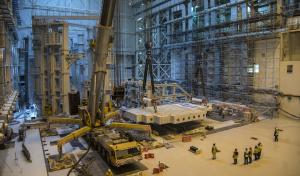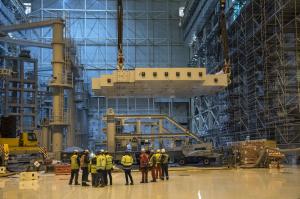Commissioning with load completed
The final test operation for the twin sector sub-assembly tools—commissioning with load—was completed in the Assembly Hall on 26 November.
With the completion of commissioning, these giant tools are now cleared for operation in 2020, when the first 440-tonne vacuum vessel sectors will be delivered to ITER. The tools will suspend the sectors vertically in their centre while they are pre-assembled with toroidal field coils and thermal shield panels prior to transport to the assembly pit.
The final commissioning activity was carried out using test loads of steel and concrete. Not only were these loads representative of the weight of toroidal field coils (360 tonnes), they also reproduced the coils' general shape and centre of gravity. During full load testing—which was carried out between July and November on first one tool then the other—the loads were secured on the tools' lateral wings and rotated inward, demonstrating that they are working according to specified requirements.
With testing completed, the test loads have now been removed from the tools and transferred to a laydown area. They will be used again in the months to come—this time to test the upending tool, which is designed to raise ITER's largest components (vacuum vessel sectors and D-shaped toroidal field coils) to an upright position.



